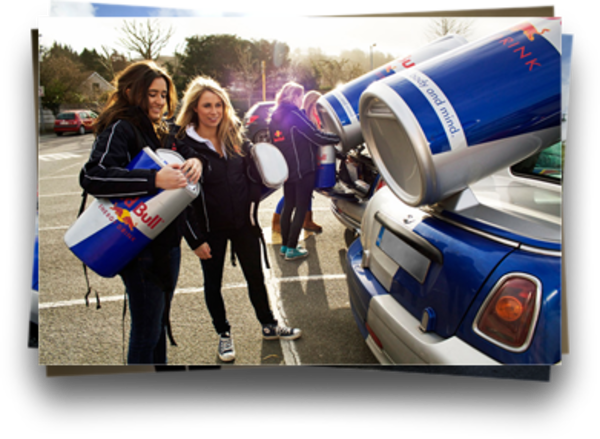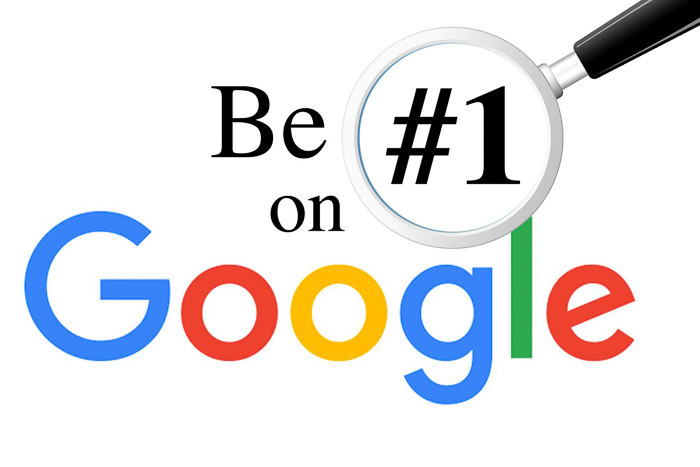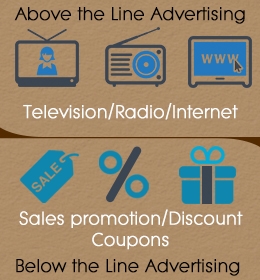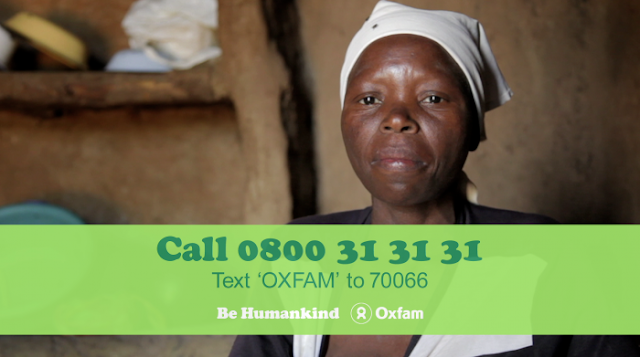

ATL, BTL and TTL Marketing – Definitions And Examples
Quick definitions of ATL, BTL and TTL marketing:
ATL Marketing Definition: Above-the-Line Marketing – widespread brand-building advertising
BTL Marketing Definition: Below-the-Line Marketing – highly targeted direct marketing focused on conversions
TTL Marketing Definition: Through-the-Line Marketing- integrated ATL and BTL marketing campaigns
Still confused? No problem, we’ll discuss these in more detail below.
First, where do the terms come from and what is the ‘Line’ in marketing?
The terms ATL and BTL were first used in 1954 after Proctor and Gamble began paying advertising firms separately (and at a different rate) from other suppliers who dealt with more direct promotional efforts. In effect, marketing that was more broad in nature was separated from marketing that was more direct in nature.
“That is the ‘Line’ in marketing – it separates direct marketing from higher level brand marketing.”
The term TTL is a relatively recent one, although to be honest I am unsure of exactly when this was first used. In any case the term TTL was coined to explain a more integrated marketing approach, which combines both the widespread and direct approaches, rather than the traditional ATL/BTL separation.
You will see these terms used with the word ‘Advertising’ too, although I’ll mostly be using ‘Marketing’ below. However, the content will apply as well to ‘Advertising’ as it does to ‘Marketing’.
More detailed definitions of ATL, BTL and TTL marketing
Here is a description of the terms mentioned above – we’ll then go on to look at a few examples a bit further down this post.
ATL Marketing Definition
‘ATL Marketing’ stands for ‘Above The Line Marketing‘. This kind of marketing is the kind of marketing that has a very broad reach and is largely untargeted. Think about a national TV campaign, where viewers across the nation see the same advert aired across the various networks.
This kind of marketing is mostly used for building brand awareness and goodwill.
BTL Marketing Definition
‘BTL Marketing’ stands for ‘Below The Line Marketing‘. This kind of marketing is the kind of marketing that targets specific groups of people with focus. For example, a leaflet drop in a specific area, a Google Adwords campaign targeting a certain group or a direct telemarketing campaign targeting specific businesses.
This kind of marketing is best for conversions and direct response.
TTL Marketing Definition
‘TTL Marketing’ stands for ‘Through The Line Marketing‘. This kind of marketing is really an integrated approach, where a company would use both BTL and ATL marketing methods to reach their customer base and generate conversions. It might seem obvious, although not all marketing campaigns are like this – some are ATL only and some are BTL only (it would be much more common to see a BTL-only marketing campaign in practice though).
This kind of marketing delivers both a wide reach and a focus on conversions.
Examples of ATL, BTL and TTL marketing activity
An Example Of Above The Line Marketing Activity
An example of Above The Line marketing would be a television campaign run by a cereal company. The ad would be aired across the nation, with every viewer seeing the exact same message. As mentioned above, this kind of marketing would be used to build general brand and awareness of the business and/or it’s products over the long term as well as goodwill.
(There would be no offers or incentives involved here).
An Example Of Below The Line Marketing Activity
The same cereal company could also run a direct marketing campaign in a large city, targeting commuters on the way to work. They might offer free cereal samples along with vouchers that could be used in a local store. This would be a strategy designed to target a specific group of people and to try and encourage quick purchases, or conversions.
A similar example of this that you might have seen before is the Red Bull Mini (shown below).
An Example Of A Through The Line Marketing Activity
In this example, a pizza company could launch a nationwide Youtube campaign that would show different video ads to different users according to where the users lived, featuring a promotional code for a discount on purchases made at their local outlet.
As you can see, this is a combination of both of the other forms – ATL in terms of it’s wide reach, BTL in terms of its targeted nature and conversion focus.
A few visual examples
Here are a few adverts that might help explain this in more detail:
ATL Marketing Example Image
 |
| Source |
Are they relevant to small businesses?
I guess that they would all be relevant to small businesses, depending on the business, the type of product they have and the target audience they have in mind. For example, BTL marketing can sometimes be the best solution for a small business serving a local catchment area.
However, if I’m thinking about the most ideal solution for the average small business owner that’s trying to serve a wider area, I’d have to say that TTL marketing was the most relevant these days. The reason for this is that put simply;
“TTL marketing can be defined as just another way of describing a well designed, integrated marketing campaign. You’re using some marketing channels with a wide reach to draw prospects into other channels that are designed focus on conversion.”
So, in that respect, it’s probably not worth worrying too much about the terms if you already have a fully developed, multi-channel marketing plan in place that helps to increase your overall brand awareness while targeting individual segments/prospects with direct response efforts once you have them in your funnel.
A successful integrated/TTL marketing campaign gives small businesses the reach and focus on conversions that can mean a very successful overall marketing campaign. Plus, as small business owners, we now have the tools and resources at our disposal to run truly effective TTL marketing campaigns, such as social media networks, sites such as YouTube as well as PPC platforms such as Adwords. They give us the reach and the focus to implement marketing strategies that have a wide reach, yet narrow focus.
However, the following points are probably worth bearing in mind when thinking about this in practice:
– Keep it digital – printed advertising/TV slots and radio are very expensive, and difficult to measure
– Digital methods such as PPC and social media allow national coverage, but in a very targeted way to suit small business needs and budgets
– Digital methods are easy to track and measure, meaning less waste and more chance of success
– All of your marketing messages should be consistent and clear at every stage (TTL campaigns work because they get the point across well all the way from brand building to conversion)
Are the ‘Lines’ becoming a bit ‘blurry’?
Now that you are up to speed on the definitions, you may be wondering if the ‘Lines’ are becoming a little ‘blurry’ in the modern age – if so, I’d say that’s a valid point to hold.
Here’s why.
The traditional ATL/BTL/TTL separation
So, as we have discussed above, the traditional separation of the ‘Lines’ goes as follows:
– Above the line: ‘brand building’ based advertising solely
– Below the line: direct, response driven marketing solely
– Through the line: ATL methods designed to feed leads into BTL based campaigns
It used to be that the following kinds of media would be considered ATL marketing activity:
– Television
– Radio
– Newspaper/magazine ads
And the following kinds of marketing would be considered BTL marketing activity:
– Door to door sales
– Telemarketing
– Direct mail
And TTL campaigns would be an integrated mix of the two.
It seems simple enough and it definitely works like that in practice, most of the time anyway.
However, the distinction described so far was mostly due to the fact that marketers and advertisers were much more limited as to what they could really do with platforms they had available to them. However, we have many more platforms and much more technology available to us. In effect, we can achieve BTL type results using what were once considered ATL methods. So now there are times when the lines seem blurry and the specific instance doesn’t fit the above criteria very well.
We’ll discuss that in more detail now, using social media as an example.
The blurring of the ‘Lines’ – the effect of social media on ATL/BTL/TTL marketing activities
One such case in which it becomes difficult to classify whether a promotional activity should be termed ATL, BTL or TTL is when you use images within your social media campaigns.
For example, consider the following:
Let’s say you want to use an image in your social media campaign and you wonder if it should be considered ATL, BTL or TTL. You realise that social media offers a huge reach and hefty exposure – meaning it could be considered ATL – but that it can also be very highly targeted, so it could be BTL too. So, does that mean it should just be considered TTL then?
The answer is ‘Probably, but not all of the time’ – to effectively classify this, we would have to begin by asking a couple of questions:
Working out your intent
First, what is my intent with the image?
– Is it used to generate some kind of response?
– Or is it used only to add to the appeal/goodwill of the brand?
– Or is it being used as a Facebook Ad and thereby targeted so that a very specific audience can see it/share it/like it?
For example, it could be that the image was used with a message saying something like ‘Get 10% Off’ and was delivered through the Facebook Ad Platform – this could be classified as a BTL campaign regardless of the fact that a social media platform is being used as response driven messaging specifically targeted to certain market segments.
The strict TTL option would be if the image was used to promote ‘10% Off’ but was only added to to the page as a normal image so that anyone who ‘likes’ the page could see it (therefore it’s not nearly as targeted).
Also, note that because the image contained a 10% offer, it could not be considered ATL as it has a direct response element attached to it – the only options are below-the-line or through-the-line.
In short, I’d say the Through the line method was the most applicable in situations as described above, but hopefully you can see why this would not always be the case. In every case the answer depends on a couple of variables, although you should be able to work it out by asking yourself the questions outlines above.
Now, let’s have a look at a list of 20 common ATL and BTL marketing methods
Above-the-Line (ATL) Promotional Actvities
All of the ATL promotional methods below are very similar in intent, they only differ in advertising medium (therefore there is little point in me writing different descriptions for each). You’ll have first hand experience of this type of marketing – brand-building adverts that are run across the nation, designed to keep products in your mind at all times. As discussed above, there is no direct response element here, they are only deployed to increase brand awareness and goodwill.
– Television advert
– Newspaper/Magazine advert
– Radio advert
– Tube Underground advert
– Outdoor billboard
– Cinema advert
– Premier football league sponsorship (okay, maybe not for most small businesses anyway, so we won’t count this one)
I would like to say a quick note about the following option however as I think it differs slightly from the ‘traditional’ methods above.
General social media profiles
Put simply, social media (in fact, all of the internet technology we are all familiar with nowadays) was not around when the ATL/BTL distinction was developed back in the 1950’s. And, in modern times, social media is actually pretty difficult to define as either ATL, BTL or TTL (we will discuss that properly further down this post).
However, I think that generally speaking, social media profiles can be considered ‘Above-the-Line’ because they are set up and published for all to see. What we do within these profiles can be considered ATL, BTL or TTL, although the basic profile itself should be classed ATL.
Now, we’ll have a look at some of my favourite Below-the-Line methods.
Below-the-Line (BTL) Promotional Activities
Here are some BTL marketing ideas for you to consider:
Intelligence-based telemarketing
Telemarketing, but not as you know it. This kind of phone-based marketing is all about research and being smart – you’ll have researched the company/person in detail and you will know exactly what you can do for that specific person. There is no thundering your way through a phone-book here – you’re contacting a list of pre-screened people you are sure you can help.
You can read more about this in my free 12,000 word guide on modern day telemarketing.
Targeted leaflet drop
Check your local authority rules here, but a great way of generating some quick business is through a targeted leaflet drop. For example, if you supply garden maintenance services to residents of a particular area, a well designed leaflet containing an offer might just do the trick. Just make sure that you are allowed to drop leaflets through residences of your target area by law. If so, this can be an excellent advertising medium.
Tradeshow/exhibition Staff
Tradeshows and exhibitions are a great way to get right in front of your target audience. You are your products and services have the chance to directly engage with potential buyers and influencers – the rewards can be substantial. I’ve actually written a post on how you can go about generating leads at tradeshows and exhibitions – you can get to that here.
Shopping center stand/Mall stand
In-person demonstrations
Arranging in-person demonstrations is one of my most favourite BTL methods for the promotion of products, particularly B2B. What can be better than arranging a private demo of your product with someone who has expressed their interest in what you offer? This can also be done online with systems such as Go To Meeting and similar.
Door-to-door selling
This was actually how I started my marketing career, although the effectiveness of the practice now is not as great as it once was. However, if you treat it the same way as I mentioned in the intelligence-based telemarketing section above, door-to-door marketing can still be very profitable.
Direct mail marketing
We all hate Spam, although there is no question that direct mail marketing works well if it is executed properly. Even blind mailings (to a specific geographic location relevant to your business) work, although it’s much better to send mail to people who have already opted in to hear from you. Past customers, people who have requested more information or updates – that’s where you’ll get the best response.
Catalogues
Email marketing
This is hands-down the most effective BTL marketing method there is. The headline figure is that it returns an average of $43 per $1 invested – a truly staggering ROI, if it’s done correctly. I couldn’t do that justice in this post, although I have written a checklist guide here to help you get started.
PPC/Social media ads
PPC/social media ads can be extremely well targeted and therefore should be considered for any BTL marketing campaign. While I said above that social media profiles are ATL in nature, any ads that you run through them are BTL as they should have a level of targeting attached to them. PPC ads are the same – even although they use a global platform with incredible reach, they are still specifically aimed at a certain segment of the population (at least they should be anyway). Here is a bit more information on getting started with PPC.

Remarketing
Similar to PPC ads, although I wanted to mention this separately as you can use this to specifically re-engage website visitors, people who have abandoned shopping carts or who have disappeared from any part of your sales funnel for any reason. Very powerful and definitely worth looking into, this is one of my favourite BTL marketing ideas listed here.. Here is a short guide on how you can start.
Post-sales coupons/incentives
Another direct BTL method is that of promoting coupons/deals/incentives to past customers. It’s much, much easier to sell to an existing customer than it is to a new one, so I like this method very much.
Point of sale promotion
Finally, I’d like to mention point of sale promotion. Specifically, I’m thinking about ‘upsells’ and ‘downsells’ here – items that you can offer to people who are already making their way through a purchase with you. This can be in person or on the web through your shopping cart. It’s a fine line between pulling this off and annoying people, although if you can find a happy medium this option can add substantially to your bottom line.
Measuring your ATL, BTL or TTL campaigns
Depending on the type of campaign you launch, there will be different ways of measuring its success, as follows:
Measuring an Above-the-Line marketing campaign
As a strict ATL campaign is designed to reach a wide audience with brand building type content, these are the types of measurements you will take, for example:
– Frequency (number of times members of target audience see your ads)
– Reach (total number of people that see your ads)
– Number of impressions (how many times your ads have been displayed across various mediums)
Measuring a Below-the-Line marketing campaign
As a BTL campaign is much more targeted in nature, you will be able to measure the following types of events, for example:
– Conversion rates – from your websites/blog/direct mail campaigns/discount offers, etc
– Click through rates (CTR) – from digital ads
– Open rates – emails/marketing automation campaigns
– Website/blog/landing page visits
– Followers and subscribers – on your blog, email lists and social media profiles, etc
Measuring a Through-the-Line marketing campaign
As you can tell from the definitions provided above, TTL campaigns provide a mix of both ATL and BTL elements and therefore the measurement of such campaigns would be made up of both measurement options above.
ATL/BTL/TTL marketing meaning in infographic form
Here is an overview of the ATL/BTL/TTL marketing meanings as an infographic:
Further reading
Hopefully this post has given you a clear idea of the ATL/BTL/TTL marketing distinctions and also where it can become a bit ‘blurry’. I also hope the Top 20 list has given you a useful list of examples you can put to use in your own campaigns.
For more information, I’d suggest you read my free, 118 page e-Book – The Beginner’s Guide To ATL/BTL/TTL Marketing Planning – which will give you everything you need to know to develop a succesful marketing strategy.
Thanks for reading, and please let me know if I can answer any questions you may have.
Kind regards,
Alan

















